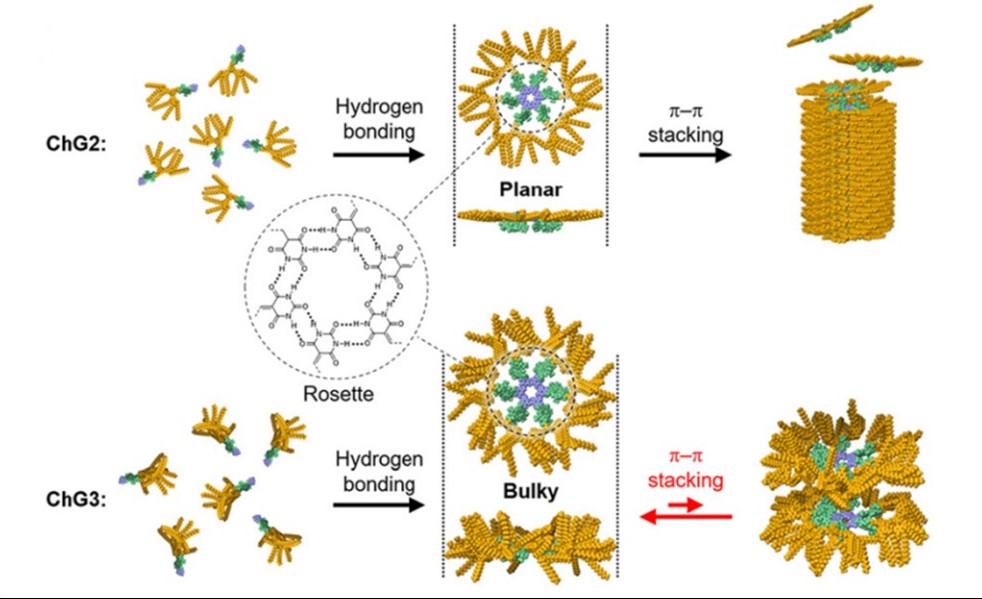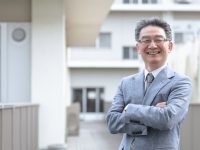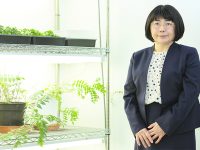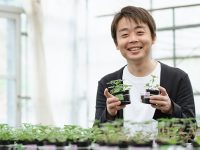Researchers explore the role of molecular modifications in advancing bioinspired light-harvesting materials
Chlorophyll (a naturally occurring pigment involved in photosynthesis)-inspired molecules hold promise for developing next-generation light-harvesting materials. However, achieving precise control over their assembly is challenging. Researchers have now revealed that attaching dendrons—branched, tree-like structures—can aid in self-assembly of chlorophyll’s materials. They found that smaller dendrons lead to stacked, fiber-like structures, while larger dendrons create spherical chlorophyll particles, advancing the development of materials that mimic the light-harvesting efficiency of natural photosynthetic systems.

Image title: Influence of dendron size on self-assembly of chlorophyll molecules.
Image caption: Researchers from Chiba University synthesized two chlorophyll derivatives (ChG2 and ChG3) that self-assemble into rosette patterns, columnar stacks, and disc-shaped aggregates depending on the solvent and the dendron generation (G2 or G3).
Image credit & source link: Ryo Kudo and Shiki Yagai from Chiba University, Japan
(https://doi.org/10.1039/d4qo01629g)
Image license: CC BY 3.0
Researchers often look to photosynthesis—a process that turns sunlight into chemical energy in plants and bacteria—as a model for innovation. Photosynthesis is in turn linked to chlorophyll pigments, tiny green molecules that play a key role in harvesting light. Naturally, these chlorophyll molecules are organized into precise structures to optimize light absorption in plants and bacteria, and efficiently capture sunlight for energy. Inspired by this natural structure, scientists have explored ways to synthetically assemble chlorophyll-based structures for applications in optoelectronics and renewable energy.
A recent study led by Professor Shiki Yagai and Mr. Ryo Kudo from the Graduate School of Engineering at Chiba University in Japan, along with a team of researchers, demonstrated how modifying chlorophyll-like molecules can direct them to form distinct structural arrangements, offering insights that could transform synthetic light-harvesting materials. The study was published in Volume 11, Issue 22 of the Organic Chemistry Frontiers on October 08, 2024.
“Photosynthetic bacteria utilize highly organized chlorophyll arrays, allowing them to capture light even in low-light conditions. We aimed to recreate these structures based on the identical synthetic molecular design, as comparing their photophysical properties might help us understand why such structures were selected in the course of evolution in nature, ” explains Prof. Yagai. To create these structures, the team modified the chlorophyll molecule by attaching a barbituric acid unit via hydrogen bonding and further added tree-like molecular structures called “dendrons” to form stable rosette-like rings and control their hierarchical stacking.
When the modified chlorophyll was dissolved in different solvents, the chlorophyll rosettes displayed a remarkable behavior. In a non-polar solvent like methylcyclohexane, chlorophyll derivatives with smaller second-generation dendrons were stacked into helical fibers, while those with bulkier, third-generation dendrons remained in smaller, disc-shaped aggregates. They could thereby assemble the chlorophyll molecules into two different forms, namely columnar stacks and discrete aggregates, mimicking the circular and tubular arrangements seen in photosynthetic bacteria. In contrast, when dissolved in chloroform, both the chlorophyll derivatives formed rosette patterns.
Using advanced imaging techniques like atomic force microscopy, transmission electron microscopy, and small-angle X-ray scattering, the team characterized the unique shapes and arrangement patterns of these synthetic chlorophyll assemblies. They found that the helical fibers formed by the second-generation dendron chlorophylls exhibited a highly ordered structure, while the third-generation dendron chlorophylls displayed a more homogeneous, spherical shape.
“Our findings show that subtle adjustments in molecular design can lead to significant differences in the final assembled structure of the chlorophyll, which could be exploited to create materials with specific light-harvesting properties,” remarks Prof. Yagai. “These insights into controlling molecular self-assembly could ignite breakthroughs in functional materials science. We are thrilled by the potential to create materials that not only mimic but surpass the capabilities of natural photosynthetic systems.”
The study thus unveils a multitude of possibilities for synthesizing light-harvesting materials by meticulously fine-tuning the assembly of chlorophyll-like structures. In particular, Prof. Yagai’s team aspires to craft materials that can mimic and even exceed natural materials in both efficiency and adaptability. With promising applications in solar energy harvesting, advanced sensors, and other technologies that rely on precise light absorption and energy transfer, these innovations could potentially revolutionize the field and redefine the possibilities in sustainable energy and beyond.
About Professor Shiki Yagai from Chiba University
Shiki Yagai is a Professor at Chiba University’s Institute for Advanced Academic Research, within the Department of Applied Chemistry and Biotechnology in the Graduate School of Engineering. Known for his expertise in supramolecular chemistry, self-assembly, and nanotechnology, Dr. Shiki Yagai has published over 204 papers. His research interests include supramolecular chemistry, supramolecular polymers, dyes, and nanostructures. Recognizing his extensive contributions to research, the Inoue Foundation for Science awarded him the Inoue Prize for Science in February 2024. He is now leading “Materials Science of Meso-Hierarchy” as a KAKENHI project of Grant-in-Aid for Transformative Research Areas.
Funding:
This work was supported by the Japan Society for the Promotion for Science (JSPS) KAKENHI grant no. JP22H00331, JP22H02203, JP23H04874, and JP23H04873.
Reference:
Title of original paper: Dendron-mediated control over self-assembly of chlorophyll rosettes into columnar vs. discrete aggregates
Authors: Ryo Kudoa, Hiroki Hanayamab, Balaraman Vedhanarayananc, Hitoshi Tamiakid, Nobuyuki Harad,e, Sarah E. Rogersf, Martin J. Hollambyg, Biplab Mannah, Koji Haranoh,i, and Shiki Yagaib,j
Affiliations:
- Division of Advanced Science and Engineering, Graduate School of Engineering, Chiba University, Japan
- Department of Applied Chemistry and Biotechnology, Graduate School of Engineering, Chiba University, Japan
- Department of Chemistry, Faculty of Engineering and Technology, SRM Institute of Science and Technology, India
- Graduate School of Life Sciences, Ritsumeikan University, Japan
- Department of Chemistry, College of Humanities & Sciences, Nihon University, Japan
- ISIS Pulsed Neutron Source, Rutherford Appleton Laboratory, UK
- Department of Chemistry, School of Chemical and Physical Sciences, Keele University, UK
- Center for Basic Research on Materials, National Institute for Materials Science, Japan
- Research Center for Autonomous Systems Materialogy, Institute of Integrated Research, Institute of Science Tokyo, Japan
- Institute for Advanced Academic Research, Chiba University, Japan
Journal: Organic Chemistry Frontiers
DOI: 10.1039/d4qo01629g
Contact: Shiki Yagai
Graduate School of Engineering, Chiba University
Email: yagai@faculty.chiba-u.jp
Public Relations Office, Chiba University
Address: 1-33 Yayoi, Inage, Chiba 263-8522 JAPAN
Email: koho-press@chiba-u.jp
Tel: +81-43-290-2018
Recommend
-

Nurturing Teaching Personnel for Multicultural Societies: High Schools-Universities-Graduate Schools’ Tripartite Collaboration to Develop Educational Programs in ASEAN Countries
2023.08.25
-

Mimicking the 500 million years of plant survival strategies to create a sustainable future
2023.01.14
-

Evolutionary Psychology: A Path to a Nature-Positive Future for Biodiversity
2025.01.31


